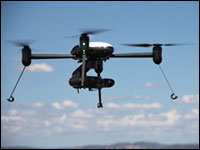
Police in North Dakota can use drones armed with what are optimistically called “nonlethal weapons,” thanks to the passage of House Bill 1328, which Gov. Jack Dalrymple signed into law this spring.
The new law gives police the authority in a roundabout way: Section 5 states a law enforcement agency may not authorize the use of an unmanned aerial vehicle armed with lethal weapons.
Lobbyist-Driven Amendments
Rep. Rick Becker, R-Bismarck, in January introduced the bill, which originally sought to ban both lethal and nonlethal weapons.
“North Dakota is at the forefront of drone technology, and I wanted it to be at the forefront of how to handle the balance between technology and law,” he told TechNewsWorld.
During judiciary committee hearings, which Becker did not attend, the bill was amended in response to law enforcement lobbying.
“My understanding is, the law enforcement lobby would probably support the bill if it included things on their wish list — and one of the things they wanted changed was the prohibition on nonlethal weapons,” Becker said.
The bill incorporated 12 amendments in the final version that was signed into law.
Understanding the Law
The law requires that police get a warrant to conduct surveillance using drones.
Such a warrant can be issued only for the investigation of a felony. The warrant must contain a data collection statement listing who will have the power to authorize the drone’s use, where it will operate, the maximum length of time each flight will take, and whether the drone will collect information or data about individuals or groups of individuals.
It includes restrictions on which personal data can be collected, its use and its retention. The law bars the use of drone surveillance of the exercise of constitutional rights.
Define ‘Nonlethal’
“It’s a terrible idea to arm drones, even with so-called nonlethal weapons, which really should be called ‘less lethal’ weapons,” said Jay Stanley, a senior policy analyst at the American Civil Liberties Union.
Tasers “kill roughly one person a week,” he told TechNewsWorld.
The Taser-related death toll in the United States had reached 500 by early 2012, according to Amnesty International.
Rubber bullets can kill too.
Arming drones “would make it too easy to use force — and when things get too easy, they tend to get overused,” Stanley warned.
Further, “the depersonalization of the decision-making process to employ a weapon on another human being is a very slippery slope,” Becker said.
On the Other Hand
“If you’re in a situation that would normally require a SWAT team, what’s the difference between using a tank as a battering ram, a sniper, or a lethally armed drone?” asked Jim McGregor.
Further, police officers’ judgment could be clouded if they have to chase a suspect who’s taken off running, but “this isn’t likely to happen with a drone operator,” he told TechNewsWorld.
“If police are given unrestricted use [of drones] for search and surveillance, I’d be very concerned,” McGregor said, “but as a tool to stop criminals that are running or hiding from the law, it’s a positive development that could save lives.”
Meetings with police, government and drone industry officials indicate other states are not likely to give police armed drones, the ACLU’s Stanley said.
Becker intends to reintroduce legislation that would prohibit both lethal and nonlethal weaponization of drones. Next time, he said, “the opposition may find it very difficult.”




















































